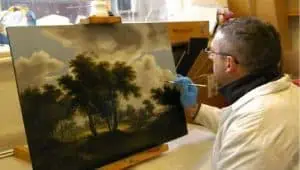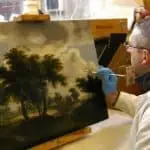Oil Painting Cleaning

Oil painting Cleaning
Restoration is a delicate and meticulous process that aims to bring out the true beauty of an artwork while preserving its integrity. One important aspect of this restoration process is oil painting cleaning, which helps to remove years of accumulated dirt, grime, and dust from the surface of the painting. In this blog post, we will explore the importance of oil painting cleaning and the techniques involved in this restoration process.
Over time, oil paintings can become dull and lose their vibrancy due to the accumulation of dirt and pollutants on their surfaces. This is particularly true for older paintings, which may have been exposed to environmental factors such as smoke, soot, and dust. Additionally, some paintings may have been varnished with a layer that has darkened or yellowed over time, further obscuring the true colors and details of the artwork. Oil painting cleaning is a crucial step in the restoration process as it helps to reveal the original colors, tones, and brushwork of the artwork.
Before the actual cleaning process begins, it is important to assess the condition of the painting and determine the appropriate cleaning methods. This is done by conducting a thorough examination of the artwork and identifying any areas of instability, such as flaking paint or weak adhesion between layers. Once the condition assessment is complete, the cleaning process can begin.
One common method of oil painting cleaning is surface cleaning, which involves gently removing the surface dirt and grime from the painting using specialized cleaning solutions and techniques. The cleaning solution is carefully chosen to suit the specific needs of the painting, ensuring that it effectively removes the dirt without damaging the underlying layers of paint. The cleaning solution is applied using soft brushes or cotton swabs, which are gently moved across the surface of the painting to lift away the dirt.
In some cases, more intensive cleaning may be required, especially when the painting has been heavily varnished or has suffered from smoke or fire damage. These situations call for a more thorough cleaning process, which involves the use of solvents and other cleaning agents to remove stubborn or ingrained dirt. It’s important to note that this type of cleaning should only be done by trained professionals, as improper handling of the cleaning agents can cause damage to both the artwork and the restorer.
After the cleaning process, additional treatments may be necessary to restore damaged areas or reapply varnish to protect the paint layers. These steps are essential in ensuring the longevity and preservation of the artwork. It’s crucial to use reversible restoration techniques that can be easily undone or modified in the future without causing any damage to the painting.
Oil painting cleaning not only improves the visual appearance of the artwork, but it also has an impact on its overall preservation. By removing layers of accumulated dirt, grime, and pollutants, the painting is protected from further deterioration. Dirt particles can act as abrasives, causing damage to the delicate paint layers over time. Cleaning the painting not only rejuvenates its appearance but also adds to its longevity and value.
Professional oil painting cleaning involves a careful balance between removing dirt and preserving the paint layers. This delicate process requires expertise and knowledge of the different types of paints, varnishes, and cleaning agents used throughout history. A professional restorer will understand the characteristics of oil paints and the varnishes commonly used in different periods, allowing them to select the appropriate cleaning methods that will yield the best results without jeopardizing the artwork’s integrity.
It’s important to mention that attempting DIY oil painting cleaning can be extremely risky and can lead to irreversible damage to the artwork. Without proper training and knowledge, it’s easy to use the wrong cleaning agents or techniques, which can cause paint to lift or alter the original colors and tones. To ensure the safe and effective cleaning of an oil painting, it’s always recommended to consult a professional restorer who specializes in art conservation.
In conclusion, oil painting cleaning is an essential step in the restoration process. Over time, oil paintings can accumulate dirt, grime, and pollutants, causing them to become dull and lose their vibrancy. By carefully removing these layers of dirt, the original colors, tones, and brushwork of the artwork are revealed, restoring its true beauty. However, it’s crucial to entrust this delicate process to a professional restorer who has the expertise and experience to handle valuable and sensitive artworks. So, if you have an oil painting in need of cleaning, don’t hesitate to reach out to a professional restorer who will bring out the hidden beauty of your artwork while preserving its integrity.
Plerase choose a professional and experiensed restorer such as Professional Painting Restorer Alan Brown of The Original Artwork Store, more valuable information here:
The Original Artwork Store
